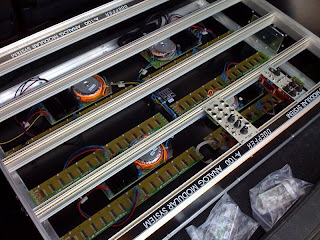
OMG, I love this module!
It's so fun. At first I thought it was going to be kind of kitschy, but the tones that are available are really quite interesting and very unique sounding. It sounds super rad through the Polivoks (who'd a thought, right?!). It's almost not quite enough that you cannot have all 8 different possible tones simultaneously. It's really fun to pick 4 and cycle through them with a sequential switch, clocked from the CLK OUT on the Gates half of the Zorlon.
The psuedo random gates are very fun too; mixing all 4 together with some kind of bi-polar mixer (A-138c) to make a pseudo random pitch sequence for the pitch input of the noise generator is too much fun, and the clock output allows you to clock other modules (like your EGs, or the aforementioned sequential switch) to it.
I know what you're thinking...clips or it never happened...I'll get them soon enough. For now, settle for the pic.
[UPDATE]
Here's a nice demo patch I made last night, but was too lazy to record (that's why the picture above still has cables patched in). The Zorlon Cannon is of course the main sound source, the 4 outputs (4bit-switch down, 5bit and 9bit-switch up, 17bit-switch down) are going to a Doepfer A-151 Sequential Switch, the output of which goes to a Harvestman Polivoks modulated by a Dual Cyclotron and A-143-1, and finally through have of a Plan B M13 low pass gate, opened by an M10 EG. The Pitch for the Zorlon noise outputs comes from the Zorlon's pseudo random gates, being mixed by a Doepfer A-138c bipolar mixer. The Clock Out on the Zorlon is triggering the M10, whose End Of Cycle output triggers the A-151 sequential switch.
So basically what you are hearing is the pseudo random gates generating the pitch sequence, the various noise outputs being "selected" by the sequential switch, and finally filtered by the Polivoks and made "plucky" by the M13 + M10.
Enjoy.


